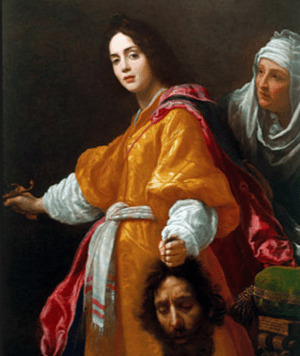Judith the Activist
In times of struggle, uncertainty, and fear, we are called to act. In the recent words of Charles Blow in the New York Times, “America needs you … now. Speak up.”
But, for those of us who do not identify as activists—those of us who are speaking up for the first time within the political system, those of us who are realizing that we need to move off of social media into more active engagement—it is easy to become discouraged and overwhelmed.
We feel an impulse to act, but it is tempting to ask instead:
- What is the power of one woman against a seemingly unstoppable tide of bad news?
- What is the power of one citizen against a wealthy demagogue and marketing genius who cynically plays to his audience?
- What is the power of one person in the face of dark forces who have intentionally weaponized human psychology and social media to prey on people’s darkest tendencies?
Can you feel the weight of these questions? They are heavy; they drag around our feet, slowing our actions, stopping us.
And so we need an antidote. We need counter-inspiration. We need examples to follow: stories that buoy us, citizens enacting change in the face of long odds, models of how to fight bravely even in dark moments. We need a Hanukkah miracle.
Enter Judith!
If you don’t know Judith, you are in for a treat. She is one of the great women characters in the Jewish tradition, even though her story is apocryphal (not included in the Hebrew Bible).
We encounter Judith as a young widow in a time of war. Three years before, her husband died suddenly and she has been wearing sackcloth and ashes ever since. Now her city is suffering under siege by the enemy general Holofernes and his army.
Children are beginning to starve, and the men in power say it is time to surrender, saying their surrender must be God’s will; but Judith insists they let her try one thing first. She takes off her sackcloth and ashes, dresses up, adorns herself with jewels, and—with her maid—walks directly into the enemy camp under the cover of darkness.
Over time, Judith talks her way into the tent of Holofernes himself, who hosts her and her maid for a private feast. She manages to get him drunk so that he falls asleep on his bed, and then, taking his own sword from his bedpost, she beheads him. Then, Judith sneaks back through the enemy camp and places his severed head on top of her city’s gate. In the morning, the enemy army awakens, sees Holofernes’ head, and flees.
While violent, I find Judith’s actions quite humane, given the circumstances. There is exactly one casualty here: the enemy general, who has been starving children.
Judith’s story shares many themes with the history of Hanukkah, and has long been associated with that holiday. Though Judith’s story is ahistorical—the names of leaders and tribes don’t align, causing some scholars to call it “historical fiction”—her story has captivated generations of Jewish people. Jewish women, especially, have kept Judith’s story alive and honored her during Hanukkah with food, dance, and celebration.
And indeed, Judith’s story is doubly significant as Hanukkah approaches this year. She is an example for all of us; much of what we hold dear is metaphorically under siege. Our democracy; our diverse and beautiful country; our forests, water, and wilderness; our rights to freedom of religion, of choice, and even of speech.
Not seeing ourselves as “activists” does not mean we do not have the power to act. Like this surprising heroine, we can transform ourselves in a moment of urgency. We can remove our clothes of mourning and put on our clothes of radiant action. We can pick up the phone, pick up the pen, write our elected officials, march in the streets, and volunteer or donate to organizations who are fighting to protect us.
Like Judith, we have more power than we know.
For more information about Judith, and Alicia’s song about her, see our free study guide. For more in-depth thoughts on Judith by Alicia, as well as her additional Girls in Trouble study guides on women in Torah through art, check out the Girls in Trouble website.










___123___Judith the Activist | Jewish Women's Archive___123___